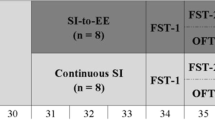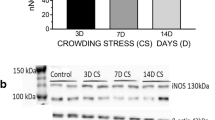Social stress is a widely experienced problem in the contemporary world; it is diverse and is determined by specific living conditions in both humans and animals. Isolation stress and crowding stress are chronic states which are actively and effectively modeled in rodents. The aim of the present work was to study the influences of these types of social stress in rats on the rate of learning to complete an operant food-procuring behavior alone and in cooperation with a conspecific. Blood corticosterone and ACTH levels were measured to assess the state of the stress-mediating hypothalamo-hypophyseal-adrenocortical system (HHACS); neurotrophins and proinflammatory cytokines were also estimated. Isolation stress, in contrast to crowding, decreased learning effectiveness – formation of a new skill – in both individual and cooperative behavior. No increases in HHACS functioning were seen in stressed animals of either group. Furthermore, animals in crowded conditions showed significant reductions in corticosterone and increases in the proinflammatory cytokine IL-1β. These results suggest that the mechanisms of action of chronic isolation and crowding stress are different both at the level of the stress-mediating system of the body and at the level of their influences on integrative brain activity.
Similar content being viewed by others
References
Alexandrov, Yu. I., Svarnik, O. E., Znamenskaya, et al., “Stress, disease, and science as conditions for regression,” Vopr. Psikhol., No. 4, 87–101 (2017).
Anacker, A. M. and Ryabinin, A. E., “Biological contribution to social influences on alcohol drinking: evidence from animal model,” Int. J. Environ. Res. Public Health, 7, No. 2, 473–493 (2010).
Armario, A., Castelhanos, J. M., and Balasch, J., “Effect of crowding on emotional reactivity in male rats,” Neuroendocrinology, 39, 330–333 (1984).
Botelho, S., Estanislau, C., and Morato, S., “Effects of under- and overcrowding on exploratory behavior in the elevated plus-maze,” Behav. Processes, 74, 357–362 (2007), https://doi.org/10.1016/j.beproc.2006.12.006.
Bugajski, J., “Social stress adapts signaling pathways involved in stimulation of the hypothalamic-pituitary-adrenal axis,” J. Physiol. Pharmacol., 50, No. 3, 367–379 (1999).
Bugajski, J., Gadek-Michalska, A., and Bugajski, A. J., “Effect of constitutive- and inducible-cyclooxygenase in the carbachol-induced pituitary-adrenocortical response during social stress,” J. Physiol. Pharmacol., 53, No. 3, 453–462 (2002).
Dronjak, S. and Gavrilović, L., “Activity of pituitary-adrenal axis in rats chronically exposed to different stressors,” Acta Vet, 55, No. 2005, 121–129.
Ferrari, P. F., Palanza, P., Parmagiani, S., and Rodgers, R. J., “Interindividual variability in Swiss male mice: relationship between social factors, aggression, and anxiety,” Physiol. Behav., 5, 821–827 (1998).
Gądek-Michalska, A., Bugajski, A., Tadeusz, J., et al., “Chronic social isolation in adaptation of HPA axis to heterotypic stress,” Pharmacol. Rep., 69, No. 6, 1213–1223 (2017).
Gądek-Michalska, A., Tadeusz, J., Bugajski, A., and Bugajski, J., “Chronic isolation stress affects subsequent crowding stress-induced brain nitric oxide synthase (NOS) Isoforms and Hypothalamic-Pituitary-Adrenal (HPA) Axis Responses,” Neurotox. Res., 36, 523–539 (2019).
Gądek-Michalska, A., Tadeusz, J., Rachwalska, et al., “Effect of prior stress on interleukin-1β and HPA axis responses to acute stress,” Pharmacol. Rep., 63, No. 6, 1393–1403 (2011).
Gavrilov, V. V. and Arutyunova, K. R., “Formation of individual experience in a model of cooperative behavior in rats,” in: Evolution and Comparative Psychology in Russian: Traditions and Perspectives, Russian Academy of Sciences Institute of Psychology Press, Moscow (2013), pp. 106–112.
Goeckner, D. J., Greenough, W. T., and Mead, W. R., “Deficits in learning tasks following chronic overcrowding in rats,” J. Person. Social Psychol., 28, No. 2, 256–261 (1973).
Gulyaeva, N. V., “Biochemical mechanisms and translational relevance of hippocampal vulnerability to distant focal brain injury: The price of stress response,” Biochemistry (Mosc.), 84, No. 11, 1306–1328 (2019b).
Gulyaeva, N. V., “Functional neurochemistry of the ventral and dorsal hippocampus: Stress, depression, dementia and remote hippocampal damage,” Neurochem. Res., 44, No. 6, 1306–1322 (2019a), https://doi.org/10.1007/s11064-018-2662-0.
Gulyaeva, N. V., “Molecular mechanisms of neuroplasticity: An expanding universe,” Biochemistry (Mosc.), 82, No. 3, 237–242 (2017), https://doi.org/10.1134/S0006297917030014.
Hilakiv, L. A., Ota, M., and Lister, R. G., “Effect of isolation on brain monoamines and the behavior of mice in tests of exploration, locomotion, anxiety and behavior ‘despair’,” Pharmacol. Biochem. Behav., 33, 371–374 (1989).
Johnson, J. D., Campisi, J., Sharkey, C., et al., “Catecholamines mediate stress-induced increases in peripheral and central inflammatory cytokines,” Neuroscience, 135, 1295–1307 (2005).
Łopuch, S. and Popik, P., “Cooperative behavior of laboratory rats (Rattus norvegicus) in an instrumental task,” J. Comp. Psychol., 125, No. 2, 250–253 (2011).
Lupien, S. J., McEwen, B. S., Gunnar, M. R., and Heim, C., “Effects of stress throughout the lifespan on the brain, behaviour and cognition,” Nat. Rev. Neurosci., 10, 434–445 (2009), https://doi.org/10.1038/nrn2639.
McCusker, R. H. and Kelley, K. W., “Immune-neural connections: how the immune system’s response to infectious agents influences behavior,” J. Exp. Biol., 216, 84–98 (2013).
Miachon, S., Rochet, T., Mathian, B., et al., “Long-term isolation of Wistar rats alters brain monoamine turnover, blood corticosterone, and ACTH,” Brain Res. Bull., 32, No. 6, 611–614 (1993).
Morrison, B. J. and Thatcher, K., “Overpopulation effect on social reduction of emotionality in the albino rat,” J. Comp. Physiol. Psychol., 69, 658–662 (1969).
Pellow, S., Chopin, P., File, S. E., and Briley, M., “Validation of open: closed arm entries in an elevated plus-maze as a measure of anxiety in the rat,” J. Neurosci. Methods, 14, 149–167 (1985).
Quan, N. and Banks, W. A., “Brain-immune communication pathways,” Brain Behav. Immun., 21, 727–735 (2007).
Ruis, M. A., te Brake, J. H., Buwalda, B., et al., “Housing familiar male wildtype rats together reduces the long-term adverse behavioural and physiological effects of social defeat,” Psychoneuroendocrinology, 24, 285–300 (1999).
Sánchez, M. M., Aguado, F., Sánchez-Toscano, F., and Saphier, D., “Neuroendocrine and immunocytochemical demonstrations of decreased hypothalamo-pituitary-adrenal axis responsiveness to restraint stress after long-term social isolation,” Endocrinology, 139, No. 2, 579–587 (1998).
Sandi, C. and Haller, J., “Stress and the social brain: behavioural effects and neurobiological mechanisms,” Nat. Rev. Neurosci., 16, No. 5, 290–304 (2015), https://doi.org/10.1038/nrn3918.
Schuster, R., “Cooperative coordination as a social behavior,” Hum. Nat., 13, 47–83 (2002).
Serra, M., Pisu, M. G., Floris, I., and Biggio, G., “Social isolation-induced changes in the hypothalamic-pituitary-adrenal axis in the rat,” Stress, 8, No. 4, 259–264 (2005).
Shabanov, P. D. and Lebedev, A. A., “Zoosocial behavior in rats,” Obz. Klin. Farmakol. Lekarstv. Ter., 5, No. 31, 2–77 (2007).
Uarquin, D. G., Meyer, J. S., Cardenas, F. P., and Rojas, M. J., “Effect of overcrowding on hair corticosterone concentrations in juvenile male Wistar rats,” J. Am. Assoc. Lab. Anim. Sci., 55, No. 6, 749–755 (2016).
Weiss, I. C., Pryce, C. R., Jongen-Relo, A. L., et al., “Effect of social isolation on stress-related behavioural and neuroendocrine state in the rat,” Behav. Brain Res., 152, 279–295 (2004).
Author information
Authors and Affiliations
Corresponding author
Additional information
Translated from Zhurnal Vysshei Nervnoi Deyatel’nosti imeni I. P. Pavlova, Vol. 71, No. 5, pp. 710–719, September–October, 2021.
Rights and permissions
Springer Nature or its licensor holds exclusive rights to this article under a publishing agreement with the author(s) or other rightsholder(s); author self-archiving of the accepted manuscript version of this article is solely governed by the terms of such publishing agreement and applicable law.
About this article
Cite this article
Gavrilov, V.V., Onufriev, M.V., Moiseeva, Y.V. et al. Chronic Social Isolation Stress and Crowding in Rats Have Different Effects on Learning an Operant Behavior and the State of the Hypothalamo-Hypophyseal-Adrenocortical System. Neurosci Behav Physi 52, 698–704 (2022). https://doi.org/10.1007/s11055-022-01295-3
Received:
Accepted:
Published:
Issue Date:
DOI: https://doi.org/10.1007/s11055-022-01295-3




